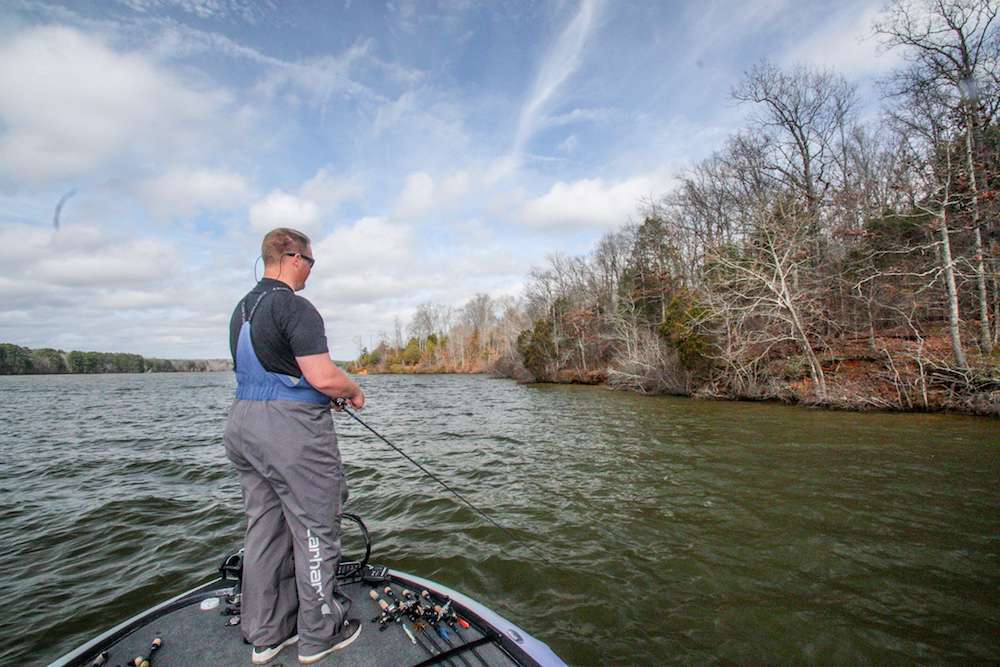
The bass are beginning to move toward their spawning areas in the South, and they will be doing so throughout the rest of the country in the coming weeks and months. That means it’s time to get serious about shallow water cranking.
Whenever the water creeps up over 50 degrees, I’ll be casting shallow crankbaits. I’ve caught bass on shallow cranks in water under 50 degrees, but the 50-degree mark is when the action really picks up.
Four shallow 6th Sense crankbaits keep a bow in my line throughout this prespawn migration. The water temperature tells me which of these baits I need to be casting.
I start with the 6th Sense Curve 55 when the water temperature is in the low 50s. That bait has a round bill and gets 5 to 9 feet deep. An internal weight swings left and right and makes the Curve 55 swim with an unpredictable hunting motion, kind of like a Wiggle Wart. It’s a great search bait.
I throw it on 45-degree banks and channel swing banks from the mouths of creeks to about halfway back. Any bank with chunk rock is good. I want that bait to get down there and really beat on those rocks. The more things you can bounce it off of the better. I give it a steady retrieve. Not slow, but not fast either.
The bait color varies depending on the water’s color. I like red, orange or a crawfish pattern in lakes where I live in North Carolina because the water is usually stained at this time of year. I go with a shad color if the water is clear. That applies to all my shallow prespawn crankbait fishing.
When the water warms to the middle 50s I switch to the 6th Sense Crush Flat 75X. This flat-sided crankbait has a tight wiggle and dives 4 to 6 feet deep. It’s kind of unique because it has a square bill and is awesome at coming through cover. Most flat crankbaits have round bills and tend to snag in cover.
I’m still fishing rocky banks and digging the bottom, but I’m starting half way back in a creek and working farther into it. I also increase the retrieve speed.
The bass become much more active and aggressive when the water warms to the upper 50s. That’s when I go with the 6th Sense 50X Squarebill. This buoyant 3/8-ounce bait runs 2 to 5 feet deep. It has a great hunting action and plows through and over cover without snagging.
By this time the bass are making their way into spawning areas in the backs of creeks. I concentrate on the last channel swing bank in the back of a creek, the last boat docks in a creek and whatever cover the bass might relate to on spawning flats. If there’s any riprap present, I never pass it up.
I cast all three of these baits with a glass 7-foot, medium-heavy ALX IKOS Hustler crankbait rod. I pair it with a Lew’s Team Lite 6:8.1 gear ratio reel and 12-pound P-Line Tactical Fluorocarbon. I go up to 15-pound when I’m grinding the 50X square bill over rough rock or wood.
I use another rod when I’m casting the fourth shallow crankbait in my prespawn arsenal, the lipless 1/2-ounce, 6th Sense Quake Thud70. I’m often making long casts over flats with this crankbait, so I need a little more power for setting the hook. The 7-foot, 1-inch, graphite ALX Zolo medium-heavy Deputy casting rod gets the job done. I match it with the same reel and line as with my other three shallow cranking lures.
The Thud does what its name implies. An internal knocker makes an intense single knocking thud. I believe that sound appeals to big bass.
The Thud is more of an open water bait. I retrieve it over flats and flat points near the backs of creeks and in ditches lined with stumps. I reel it fast or yo-yo it over the bottom.
With these four shallow crankbaits I can keep pace with the bass wherever they happen to be throughout this prespawn phase.

